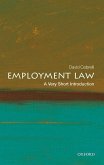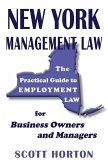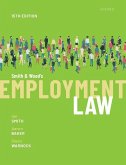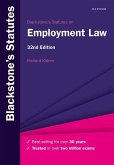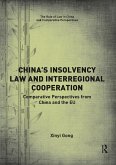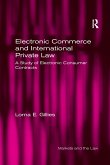- Broschiertes Buch
- Merkliste
- Auf die Merkliste
- Bewerten Bewerten
- Teilen
- Produkt teilen
- Produkterinnerung
- Produkterinnerung
This book provides clear and concise explanations to over 200 questions on China's current employment laws. It helps readers answer the question: "what are my rights and what should I do?" in given practical situations.
Andere Kunden interessierten sich auch für
![Employment Law Employment Law]() David CabrelliEmployment Law17,99 €
David CabrelliEmployment Law17,99 €![New York Management Law New York Management Law]() Scott HortonNew York Management Law21,99 €
Scott HortonNew York Management Law21,99 €![Smith & Wood's Employment Law Smith & Wood's Employment Law]() Ian Smith (Barrister and Barrister Emeritus Professor of Employment Law and University of East Anglia Emeritus Professor of Employment Law)Smith & Wood's Employment Law66,99 €
Ian Smith (Barrister and Barrister Emeritus Professor of Employment Law and University of East Anglia Emeritus Professor of Employment Law)Smith & Wood's Employment Law66,99 €![Blackstone's Statutes on Employment Law Blackstone's Statutes on Employment Law]() Richard KidnerBlackstone's Statutes on Employment Law16,99 €
Richard KidnerBlackstone's Statutes on Employment Law16,99 €![Blackstone's Employment Tribunals Handbook 2014-15 Blackstone's Employment Tribunals Handbook 2014-15]() John SprackBlackstone's Employment Tribunals Handbook 2014-15120,99 €
John SprackBlackstone's Employment Tribunals Handbook 2014-15120,99 €![China's Insolvency Law and Interregional Cooperation China's Insolvency Law and Interregional Cooperation]() Xinyi GongChina's Insolvency Law and Interregional Cooperation65,99 €
Xinyi GongChina's Insolvency Law and Interregional Cooperation65,99 €![Electronic Commerce and International Private Law Electronic Commerce and International Private Law]() Lorna E GilliesElectronic Commerce and International Private Law81,99 €
Lorna E GilliesElectronic Commerce and International Private Law81,99 €-
This book provides clear and concise explanations to over 200 questions on China's current employment laws. It helps readers answer the question: "what are my rights and what should I do?" in given practical situations.
Hinweis: Dieser Artikel kann nur an eine deutsche Lieferadresse ausgeliefert werden.
Hinweis: Dieser Artikel kann nur an eine deutsche Lieferadresse ausgeliefert werden.
Produktdetails
- Produktdetails
- Verlag: Taylor & Francis Ltd
- Seitenzahl: 366
- Erscheinungstermin: 1. April 2025
- Englisch
- Abmessung: 246mm x 174mm
- ISBN-13: 9781032951256
- ISBN-10: 1032951257
- Artikelnr.: 72107318
- Herstellerkennzeichnung
- Libri GmbH
- Europaallee 1
- 36244 Bad Hersfeld
- gpsr@libri.de
- Verlag: Taylor & Francis Ltd
- Seitenzahl: 366
- Erscheinungstermin: 1. April 2025
- Englisch
- Abmessung: 246mm x 174mm
- ISBN-13: 9781032951256
- ISBN-10: 1032951257
- Artikelnr.: 72107318
- Herstellerkennzeichnung
- Libri GmbH
- Europaallee 1
- 36244 Bad Hersfeld
- gpsr@libri.de
Dong Wang is a barrister and solicitor in New Zealand. He is a former part-time employment arbitrator of the Shenzhen Employment Dispute Arbitration Committee, a member of the Guangdong Employment Law Society, and an expert witness on Chinese employment law for the Supreme Court of Queensland, Australia, with extensive theoretical and practical experience. Peng Zhao is the director of Royal Law Firm, China. He has extensive practical experience in employment dispute cases, including the 2016 Linak case before the Supreme Court of China. He is also highly experienced as corporate legal counsel for business operations, covering commercial law, company law, and intellectual property law.
Preface
Glossary of Common Terms
Chapter 1 EMPLOYMENT RELATIONS
Introduction
1.1 Employment Relations: Principle and Classification
1.2 Difference between Employment and Contract Relations
1.3 Special Types of Workers and Work Relations
1.4 Labor Dispute Procedure
Chapter 2 EMPLOYMENT COMMENCEMENT
Introduction
2.1 Employer Obligations at the Start
2.2 Double-Wage Damages and Employer Immunity
2.3 Calculation of Double-Wage Damages
2.4 Probation Period and Validity of Employment
Chapter 3 EMPLOYEE ENTITLEMENTS
Introduction
3.1 Employee Leaves and Special Entitlements
3.2 Sick Leave and Female Employee Rights
3.3 Employers Handling Work Injuries
3.4 Employee Entitlements for Work Injuries
Chapter 4 PERFORMANCE OF EMPLOYMENT CONTRACT
Introduction
4.1 Wage Entitlements, Calculation, and Payment
4.2 Employer Management and Disciplinary Actions
4.3 Strike, Equity Incentive, and Employer Misconduct
Chapter 5 EMPLOYMENT TERMINATION
Introduction
5.1 Resignation, Retirement, and Party Demise
5.2 Employer-Initiated Employment Termination
5.3 Calculation of Termination Compensations
5.4 Other Issues for Employment Termination
Chapter 6 TRADE SECRETS AND NON-COMPETITION
Introduction
6.1 Trade Secret Protection
6.2 Non-Competition
6.3 Personal Information Protection
Chapter 7 SUMMARY AND PRACTICAL GUIDELINES
Introduction
7.1 Principles of Conduct in Employment Relationships
7.2 Collective Contracts and Individual Contracts
7.3 Distinguishing between Employment Relations and Contractor Relations
7.4 Selecting Different Types of Employment Contracts During Recruitment
7.5 Rights and Obligations under General Work Hours or Irregular Work Hours
Employment Contracts
7.6 Rights and Obligations under Part-Time Employment Contracts
7.7 Rights and Obligations under Labor Dispatch Contracts
7.8 Judicial Procedures for Employment Disputes
7.9 Matters Related to Recruitment and Employee Onboarding
7.10 Purchase of Social Insurance
7.11 Signing Written Employment Contracts
7.12 Probationary Period for Employees
7.13 Invalidation of Employment Contract
7.14 Paid Annual Leave
7.15 Bereavement Leave
7.16 Special Protection for Female Employees
7.17 Maternity Leave and Paternity Leave
7.18 High-Temperature Allowance
7.19 Matters Related to Sick Leave
7.20 Recognition and Handling of Work Injuries
7.21 Work Injury Entitlements
7.22 Employee Wages
7.23 Employee Overtime Pay
7.24 Workplace Rights and Mental Damages
7.25 Lawful Disciplinary Actions
7.26 Employee-related Financial Compensation
7.27 Multiple Employers' Use of an Employee
7.28 Employee Position Transfer
7.29 Employee Collective Strike
7.30 Equity Incentive
7.31 Unjustified Wage Deduction and Arrear
7.32 Administrative and Criminal Penalties for Employers Violating
Employment Law
7.33 Resignation and Forced Resignation of Employees
7.34 Employee Retirement
7.35 Employee Death and Employer Demise
7.36 Lawful Dismissal
7.37 Economic Redundancy
7.38 Termination for Major Change in Objective Condition
7.39 Termination of Employment for Employee's Incompetence
7.40 Termination of Employment Due to Employee's Gross Misconduct
7.41 Protection of Trade Secrets
7.42 Non-Competition Agreement
7.43 Personal Information Protection
7.44 Company Rules and Regulations and Contracts Management
Afterword
Index
Glossary of Common Terms
Chapter 1 EMPLOYMENT RELATIONS
Introduction
1.1 Employment Relations: Principle and Classification
1.2 Difference between Employment and Contract Relations
1.3 Special Types of Workers and Work Relations
1.4 Labor Dispute Procedure
Chapter 2 EMPLOYMENT COMMENCEMENT
Introduction
2.1 Employer Obligations at the Start
2.2 Double-Wage Damages and Employer Immunity
2.3 Calculation of Double-Wage Damages
2.4 Probation Period and Validity of Employment
Chapter 3 EMPLOYEE ENTITLEMENTS
Introduction
3.1 Employee Leaves and Special Entitlements
3.2 Sick Leave and Female Employee Rights
3.3 Employers Handling Work Injuries
3.4 Employee Entitlements for Work Injuries
Chapter 4 PERFORMANCE OF EMPLOYMENT CONTRACT
Introduction
4.1 Wage Entitlements, Calculation, and Payment
4.2 Employer Management and Disciplinary Actions
4.3 Strike, Equity Incentive, and Employer Misconduct
Chapter 5 EMPLOYMENT TERMINATION
Introduction
5.1 Resignation, Retirement, and Party Demise
5.2 Employer-Initiated Employment Termination
5.3 Calculation of Termination Compensations
5.4 Other Issues for Employment Termination
Chapter 6 TRADE SECRETS AND NON-COMPETITION
Introduction
6.1 Trade Secret Protection
6.2 Non-Competition
6.3 Personal Information Protection
Chapter 7 SUMMARY AND PRACTICAL GUIDELINES
Introduction
7.1 Principles of Conduct in Employment Relationships
7.2 Collective Contracts and Individual Contracts
7.3 Distinguishing between Employment Relations and Contractor Relations
7.4 Selecting Different Types of Employment Contracts During Recruitment
7.5 Rights and Obligations under General Work Hours or Irregular Work Hours
Employment Contracts
7.6 Rights and Obligations under Part-Time Employment Contracts
7.7 Rights and Obligations under Labor Dispatch Contracts
7.8 Judicial Procedures for Employment Disputes
7.9 Matters Related to Recruitment and Employee Onboarding
7.10 Purchase of Social Insurance
7.11 Signing Written Employment Contracts
7.12 Probationary Period for Employees
7.13 Invalidation of Employment Contract
7.14 Paid Annual Leave
7.15 Bereavement Leave
7.16 Special Protection for Female Employees
7.17 Maternity Leave and Paternity Leave
7.18 High-Temperature Allowance
7.19 Matters Related to Sick Leave
7.20 Recognition and Handling of Work Injuries
7.21 Work Injury Entitlements
7.22 Employee Wages
7.23 Employee Overtime Pay
7.24 Workplace Rights and Mental Damages
7.25 Lawful Disciplinary Actions
7.26 Employee-related Financial Compensation
7.27 Multiple Employers' Use of an Employee
7.28 Employee Position Transfer
7.29 Employee Collective Strike
7.30 Equity Incentive
7.31 Unjustified Wage Deduction and Arrear
7.32 Administrative and Criminal Penalties for Employers Violating
Employment Law
7.33 Resignation and Forced Resignation of Employees
7.34 Employee Retirement
7.35 Employee Death and Employer Demise
7.36 Lawful Dismissal
7.37 Economic Redundancy
7.38 Termination for Major Change in Objective Condition
7.39 Termination of Employment for Employee's Incompetence
7.40 Termination of Employment Due to Employee's Gross Misconduct
7.41 Protection of Trade Secrets
7.42 Non-Competition Agreement
7.43 Personal Information Protection
7.44 Company Rules and Regulations and Contracts Management
Afterword
Index
Preface
Glossary of Common Terms
Chapter 1 EMPLOYMENT RELATIONS
Introduction
1.1 Employment Relations: Principle and Classification
1.2 Difference between Employment and Contract Relations
1.3 Special Types of Workers and Work Relations
1.4 Labor Dispute Procedure
Chapter 2 EMPLOYMENT COMMENCEMENT
Introduction
2.1 Employer Obligations at the Start
2.2 Double-Wage Damages and Employer Immunity
2.3 Calculation of Double-Wage Damages
2.4 Probation Period and Validity of Employment
Chapter 3 EMPLOYEE ENTITLEMENTS
Introduction
3.1 Employee Leaves and Special Entitlements
3.2 Sick Leave and Female Employee Rights
3.3 Employers Handling Work Injuries
3.4 Employee Entitlements for Work Injuries
Chapter 4 PERFORMANCE OF EMPLOYMENT CONTRACT
Introduction
4.1 Wage Entitlements, Calculation, and Payment
4.2 Employer Management and Disciplinary Actions
4.3 Strike, Equity Incentive, and Employer Misconduct
Chapter 5 EMPLOYMENT TERMINATION
Introduction
5.1 Resignation, Retirement, and Party Demise
5.2 Employer-Initiated Employment Termination
5.3 Calculation of Termination Compensations
5.4 Other Issues for Employment Termination
Chapter 6 TRADE SECRETS AND NON-COMPETITION
Introduction
6.1 Trade Secret Protection
6.2 Non-Competition
6.3 Personal Information Protection
Chapter 7 SUMMARY AND PRACTICAL GUIDELINES
Introduction
7.1 Principles of Conduct in Employment Relationships
7.2 Collective Contracts and Individual Contracts
7.3 Distinguishing between Employment Relations and Contractor Relations
7.4 Selecting Different Types of Employment Contracts During Recruitment
7.5 Rights and Obligations under General Work Hours or Irregular Work Hours
Employment Contracts
7.6 Rights and Obligations under Part-Time Employment Contracts
7.7 Rights and Obligations under Labor Dispatch Contracts
7.8 Judicial Procedures for Employment Disputes
7.9 Matters Related to Recruitment and Employee Onboarding
7.10 Purchase of Social Insurance
7.11 Signing Written Employment Contracts
7.12 Probationary Period for Employees
7.13 Invalidation of Employment Contract
7.14 Paid Annual Leave
7.15 Bereavement Leave
7.16 Special Protection for Female Employees
7.17 Maternity Leave and Paternity Leave
7.18 High-Temperature Allowance
7.19 Matters Related to Sick Leave
7.20 Recognition and Handling of Work Injuries
7.21 Work Injury Entitlements
7.22 Employee Wages
7.23 Employee Overtime Pay
7.24 Workplace Rights and Mental Damages
7.25 Lawful Disciplinary Actions
7.26 Employee-related Financial Compensation
7.27 Multiple Employers' Use of an Employee
7.28 Employee Position Transfer
7.29 Employee Collective Strike
7.30 Equity Incentive
7.31 Unjustified Wage Deduction and Arrear
7.32 Administrative and Criminal Penalties for Employers Violating
Employment Law
7.33 Resignation and Forced Resignation of Employees
7.34 Employee Retirement
7.35 Employee Death and Employer Demise
7.36 Lawful Dismissal
7.37 Economic Redundancy
7.38 Termination for Major Change in Objective Condition
7.39 Termination of Employment for Employee's Incompetence
7.40 Termination of Employment Due to Employee's Gross Misconduct
7.41 Protection of Trade Secrets
7.42 Non-Competition Agreement
7.43 Personal Information Protection
7.44 Company Rules and Regulations and Contracts Management
Afterword
Index
Glossary of Common Terms
Chapter 1 EMPLOYMENT RELATIONS
Introduction
1.1 Employment Relations: Principle and Classification
1.2 Difference between Employment and Contract Relations
1.3 Special Types of Workers and Work Relations
1.4 Labor Dispute Procedure
Chapter 2 EMPLOYMENT COMMENCEMENT
Introduction
2.1 Employer Obligations at the Start
2.2 Double-Wage Damages and Employer Immunity
2.3 Calculation of Double-Wage Damages
2.4 Probation Period and Validity of Employment
Chapter 3 EMPLOYEE ENTITLEMENTS
Introduction
3.1 Employee Leaves and Special Entitlements
3.2 Sick Leave and Female Employee Rights
3.3 Employers Handling Work Injuries
3.4 Employee Entitlements for Work Injuries
Chapter 4 PERFORMANCE OF EMPLOYMENT CONTRACT
Introduction
4.1 Wage Entitlements, Calculation, and Payment
4.2 Employer Management and Disciplinary Actions
4.3 Strike, Equity Incentive, and Employer Misconduct
Chapter 5 EMPLOYMENT TERMINATION
Introduction
5.1 Resignation, Retirement, and Party Demise
5.2 Employer-Initiated Employment Termination
5.3 Calculation of Termination Compensations
5.4 Other Issues for Employment Termination
Chapter 6 TRADE SECRETS AND NON-COMPETITION
Introduction
6.1 Trade Secret Protection
6.2 Non-Competition
6.3 Personal Information Protection
Chapter 7 SUMMARY AND PRACTICAL GUIDELINES
Introduction
7.1 Principles of Conduct in Employment Relationships
7.2 Collective Contracts and Individual Contracts
7.3 Distinguishing between Employment Relations and Contractor Relations
7.4 Selecting Different Types of Employment Contracts During Recruitment
7.5 Rights and Obligations under General Work Hours or Irregular Work Hours
Employment Contracts
7.6 Rights and Obligations under Part-Time Employment Contracts
7.7 Rights and Obligations under Labor Dispatch Contracts
7.8 Judicial Procedures for Employment Disputes
7.9 Matters Related to Recruitment and Employee Onboarding
7.10 Purchase of Social Insurance
7.11 Signing Written Employment Contracts
7.12 Probationary Period for Employees
7.13 Invalidation of Employment Contract
7.14 Paid Annual Leave
7.15 Bereavement Leave
7.16 Special Protection for Female Employees
7.17 Maternity Leave and Paternity Leave
7.18 High-Temperature Allowance
7.19 Matters Related to Sick Leave
7.20 Recognition and Handling of Work Injuries
7.21 Work Injury Entitlements
7.22 Employee Wages
7.23 Employee Overtime Pay
7.24 Workplace Rights and Mental Damages
7.25 Lawful Disciplinary Actions
7.26 Employee-related Financial Compensation
7.27 Multiple Employers' Use of an Employee
7.28 Employee Position Transfer
7.29 Employee Collective Strike
7.30 Equity Incentive
7.31 Unjustified Wage Deduction and Arrear
7.32 Administrative and Criminal Penalties for Employers Violating
Employment Law
7.33 Resignation and Forced Resignation of Employees
7.34 Employee Retirement
7.35 Employee Death and Employer Demise
7.36 Lawful Dismissal
7.37 Economic Redundancy
7.38 Termination for Major Change in Objective Condition
7.39 Termination of Employment for Employee's Incompetence
7.40 Termination of Employment Due to Employee's Gross Misconduct
7.41 Protection of Trade Secrets
7.42 Non-Competition Agreement
7.43 Personal Information Protection
7.44 Company Rules and Regulations and Contracts Management
Afterword
Index


